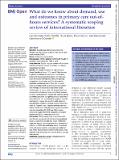What do we know about demand, use and outcomes in primary care out-of-hours services? A systematic scoping review of international literature
Abstract
Objective To synthesise international evidence for demand, use and outcomes of primary care out-of-hours health services (OOHS). Design Systematic scoping review. Data sources CINAHL; Medline; PsyARTICLES; PsycINFO; SocINDEX; and Embase from 1995 to 2019. Study selection English language studies in UK or similar international settings, focused on services in or directly impacting primary care. Results 105 studies included: 54% from mainland Europe/Republic of Ireland; 37% from UK. Most focused on general practitioner-led out-of-hours cooperatives. Evidence for increasing patient demand over time was weak due to data heterogeneity, infrequent reporting of population denominators and little adjustment for population sociodemographics. There was consistent evidence of higher OOHS use in the evening compared with overnight, at weekends and by certain groups (children aged <5, adults aged >65, women, those from socioeconomically deprived areas, with chronic diseases or mental health problems). Contact with OOHS was driven by problems perceived as urgent by patients. Respiratory, musculoskeletal, skin and abdominal symptoms were the most common reasons for contact in adults; fever and gastrointestinal symptoms were the most common in the under-5s. Frequent users of daytime services were also frequent OOHS users; difficulty accessing daytime services was also associated with OOHS use. There is some evidence to suggest that OOHS colocated in emergency departments (ED) can reduce demand in EDs. Conclusions Policy changes have impacted on OOHS over the past two decades. While there are generalisable lessons, a lack of comparable data makes it difficult to judge how demand has changed over time. Agreement on collection of OOHS data would allow robust comparisons within and across countries and across new models of care. Future developments in OOHS should also pay more attention to the relationship with daytime primary care and other services.
Citation
Foster , H , Moffat , K R , Burns , N , Gannon , M , Macdonald , S & O'Donnell , C A 2020 , ' What do we know about demand, use and outcomes in primary care out-of-hours services? A systematic scoping review of international literature ' , BMJ Open , vol. 10 , no. 1 , e033481 . https://doi.org/10.1136/bmjopen-2019-033481
Publication
BMJ Open
Status
Peer reviewed
ISSN
2044-6055Type
Journal article
Description
This study was funded by the Scottish Government through the Primary Care Division and Health Improvement Scotland.Collections
Items in the St Andrews Research Repository are protected by copyright, with all rights reserved, unless otherwise indicated.

